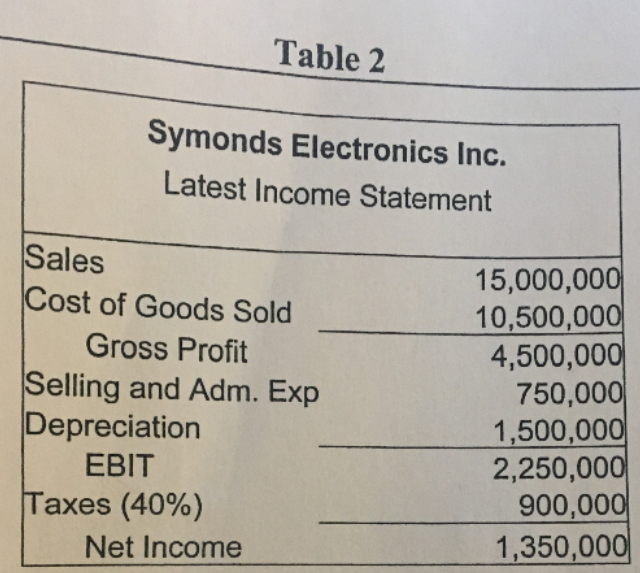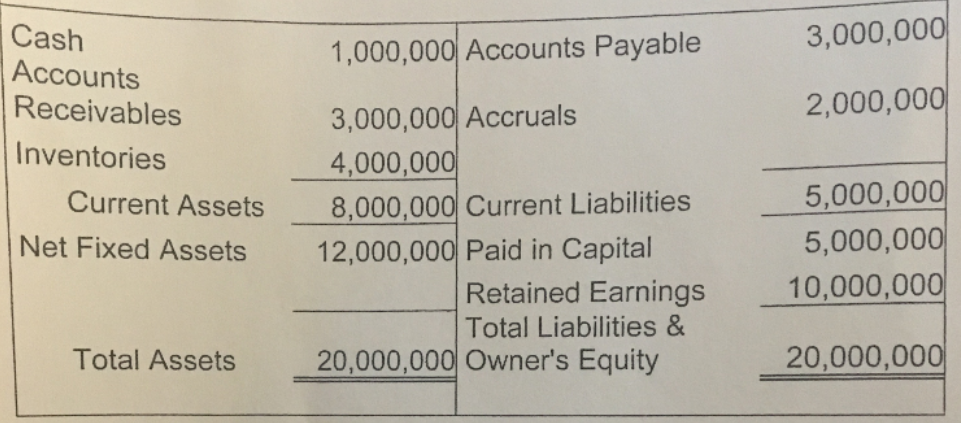Question
Debt Versus Equity Financing Look Before You Leverage! Why do things have to be so complicated? said Bob to Andrew, as he sat at his
Debt Versus Equity Financing Look Before You Leverage! Why do things have to be so complicated? said Bob to Andrew, as he sat at his desk shuffling papers around. I need you to come up with a convincing argument. Bobs company, Symonds Electronics, had embarked upon an expansion project, which had the potential of increasing sales by about 30% per year over the next 5 years. The additional capital needed to finance the project had been estimated at $5,000,000. What Bob was wondering about was whether he should burden the firm with fixed rate debt or issue common stock to raise the needed funds. Having had no luck with getting the board of directors to vote on a decision, Bob decided to call on Andrew Lamb, his Chief Financial Officer, to shed some light on the matter.
Bob Symonds, the Chief Executive Officer of Symonds Electronics, established his company about 10 years ago in his hometown of Cincinnati, Ohio. After taking early retirement at age 55, Bob felt that he could really capitalize on his engineering knowledge and contacts within the industry. Bob remembered vividly how easily he had managed to get the company up and running by using $3,000,000 of his own saving sand a five-year bank note worth $2,000,000. He recollected how uneasy he had felt about that debt burden and the 14% per year rate of interest that the bank had been charging him. He remembered distinctly how relieved he had been after paying off the loan one year earlier than its five-year term, and the surprised look on the bank managers face.
Business had been good over the years and sales had doubled about every 4 years. As sales began to escalate with the booming economy and thriving stock market, the firm had needed additional capital. Initially, Bob had managed to grow the business by using internal equity and spontaneous financing sources. However, about 5 years ago, when the need for financing was overwhelming, Bob decided to take the company public via an initial public offering (IPO) in the over-the-counter market. The issue was very successful and oversubscribed, mainly due to the superb publicity and marketing efforts of the investment underwriting company that Bob hired. The company sold 1 million shares at $5 per share. The stock price had grown steadily overtime and was currently trading at its book value of $15 per share.
When the expansion proposal was presented at last weeks board meeting, the directors were unanimous about the decision to accept the proposal. Based upon the estimates provided by the marketing department, the project had the potential of increasing revenues by between 10 %( Worst Case) and 50 %( Best Case) per year.
The internal rate of return was expected to far outperform the companys hurdle rate. Ordinarily, the project would have been started using internal and spontaneous funds. However, at this juncture, the firm had already invested all its internal equity into the business. Thus, Bob and his colleagues were hard pressed to make a decision as to whether long-term debt or equity should be the chosen method of financing this time around.
Upon contacting their investment bankers, Bob learned that they could issue 5-year notes, at par, at a rate of 10% per year. Conversely, the company could issue common stock at its current price of $15 per share. Being unclear about what decision to make, Bob put the question to a vote by the directors. Unfortunately, the directors were equally divided in their opinion of which financing route should be chosen. Some of the directors felt that the tax shelter offered by debt would help reduce the firms overall cost of capital and prevent the firms earnings per share from being diluted. However, others had heard about homemade leverage and would not be convinced. They were of the opinion that it would be better for the firm to let investors leverage their investments themselves. They felt that equity was the way to go since the future looked rather uncertain and being rather conservative, they were not interested in burdening the firm with interest charges. Besides, they felt that the firm should take advantage of the booming stock market.
Feeling rather frustrated and confused, Bob decided to call upon his chief financial officer, Andrew Lamb, to resolve this dilemma. Andrew had joined the company about two years ago. He held an MBA from a prestigious university and had recently completed his Chartered Financial Analysts certification. Prior to joining Symonds, Andrew had worked at two other publicly traded manufacturing companies and had been successful in helping them raise capital at attractive rates, thereby lowering their cost of capital considerably. Andrew knew that he was in for a challenging task. He felt, however, that this was a good opportunity to prove his worth to the company. In preparation of his presentation, he got the latest balance sheet and income statement of the firm (see Tables 1 and 2)and started crunching out the numbers. The title of his presentation read, Look Before You Leverage!
QUESTION: Quantify the impact by projecting the income statement for the next year and computing the EPS, Net Profit Margin, ROA and ROE (based on book values) for each of the two funding options being considered, namely, funding the project using (i) equity and (ii) debt. For each option, consider three scenarios: base case (25% increase in sales), optimistic (40% increase) and pessimistic (5% increase). Make the following assumptions in your income statement projection:
i. Of the total investment of $5 million required for the expansion project, $4 million will be for fixed assets and $1 million for net working capital. Note: Additional Current Assets required will be $2.5 million, but current liabilities will also increase by $1.5 million. So the net NWC requirement is $1 million. This information is needed to compute ROA.
ii. The life of the project is 5 years and the company uses straight line depreciation.
iii. All operating costs other than depreciation are directly proportional to sales.


Table 2 Symonds Electronics Inc. Latest Income Statement Sales Cost of Goods Sold Gross Profit Selling and Adm. Exp Depreciation EBIT Taxes (40%) Net Income 15,000,000 10,500,000 4,500,000 750,000 1,500,000 2,250,000 900,000 1,350,000 1,000,000 Accounts Payable 3,000,000 Cash Accounts Receivables Inventories Current Assets 2,000,000 Net Fixed Assets 3,000,000 Accruals 4,000,000 8,000,000 Current Liabilities 12,000,000 Paid in Capital Retained Earnings Total Liabilities & 20,000,000 Owner's Equity 5,000,000 5,000,000 10,000,000 Total Assets 20,000,000 Table 2 Symonds Electronics Inc. Latest Income Statement Sales Cost of Goods Sold Gross Profit Selling and Adm. Exp Depreciation EBIT Taxes (40%) Net Income 15,000,000 10,500,000 4,500,000 750,000 1,500,000 2,250,000 900,000 1,350,000 1,000,000 Accounts Payable 3,000,000 Cash Accounts Receivables Inventories Current Assets 2,000,000 Net Fixed Assets 3,000,000 Accruals 4,000,000 8,000,000 Current Liabilities 12,000,000 Paid in Capital Retained Earnings Total Liabilities & 20,000,000 Owner's Equity 5,000,000 5,000,000 10,000,000 Total Assets 20,000,000
Step by Step Solution
There are 3 Steps involved in it
Step: 1

Get Instant Access to Expert-Tailored Solutions
See step-by-step solutions with expert insights and AI powered tools for academic success
Step: 2

Step: 3

Ace Your Homework with AI
Get the answers you need in no time with our AI-driven, step-by-step assistance
Get Started


